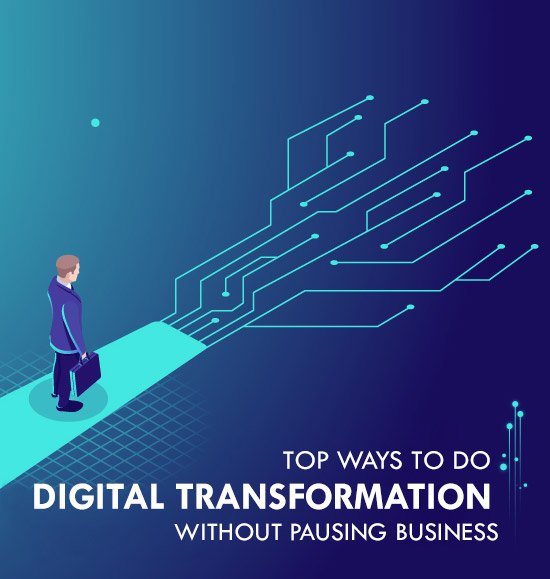The latest technologies are significantly affecting and transforming the way people communicate and conduct business. How are enterprises coping with this evolving corporate landscape?
The trajectory of the digital transformation journey has always been full of hindrances and problems. When the latest technologies started significantly and digitally transforming the way people communicate, interact, and collaborate with enterprises, the majority of business owners realized that it is a matter of survival in the highly competitive corporate landscape.
Since then, every enterprise has been aware of the fact that digital solutions are vital for success. However, the percentage of enterprises that invest in a digital transformation strategy is surprisingly less. This gives birth to a burning question what’s hindering enterprises from adopting digital transformation solutions?
The last ten years of information technology have been about modifying the way people work and conduct businesses. The following ten years will certainly be about seamlessly transforming businesses.
However, a lot of enterprises are skeptical that they’ll have to pause their business process while they are undergoing digital transformation. However, with proper planning and monitoring by a leading and trusted digital transformation partner like Copperchips, one can seamlessly conduct digital transformation without affecting the business processes.
5 Ways To Conduct Digital Transformation Without Pausing Business

Digital transformation enables large enterprises to stay ahead of their competition. This is why digital transformation projects are usually large in ambition and scope, however, there are always some possibilities of risk. With that said, let us get to know some tips to conduct digital transformation without any downtime.
Phase-Wise Approach
Instead of adopting the traditional “tear and replace” methodology, enterprises need to approach digital transformation in a more efficient way to completely avoid the risk of downtime. One can consider adopting a phased approach to cut short the risk in your digital transformation journey. One can also release a minimum viable product (MVP) early to receive realistic feedback and criticism. This phased approach will allow you to focus on each stage separately to make the required changes and build a customer-centric product.
To cope with the digital downtime, the first phase should always include creating and deploying a front-end proxy. The proxy will give the required data. Only after receiving the data, one should move to the second phase. The second phase includes the replacement of the old stack.
Identify Problems Earlier
Downtime can even be caused by a native problem, for instance, a software glitch in a workstation, remote server, a major event, or any other reason. Hence, for a major digital transformation phase, one needs to develop an early warning system to test things in each and every phase, so that not much time is wasted in locating and fixing the issues.
Locating issues earlier also assists in having a solution right there, so when the issue occurs then it is easier to correct it without impacting any productivity. With a little amount of testing, iterating, and assessing, one can easily and effectively manage traffic to the new system and locate any potential problems way earlier.
Plan For Accuracy and Reliability
While undergoing a digital transformation for your enterprise. You must visualize, collect, and alert on in-depth operational metrics. It’s even better to have a dynamic plan. To ensure functional accuracy and operational reliability. This helps to minimize or eliminate the chances of errors and switch toward the next step. Then comes the development of the skill to facilitate standard operations, reduce downtime, enable quick decision-making, permit employees to attain the skill effectively, and enhance brand reliability.
The accuracy provides a simple yet effective digital strategy framework to locate important components within the system and the reliability assists in decision-making which is meant to enhance the system availability or cut short the mean duration of system downtime.
Establish A Multi-Layered Fallback Mechanism
Multi-Layered Fallback Mechanism assists in reducing the use of the old system. It also helps in depreciating the impact and elegantly degrading in case of any issues. This mechanism ensures that the problems arising in one service do not cause any damage to the overall operations.
During digital transformation, one needs to make sure that one’s team gets acquainted with the use of novel systems. This helps to prevent the product or service quality from further degrading. That’s why it is always a good idea to plan for multiple layers of fallback to keep you on the safer side.
Keep Everyone Involved In The Plan
One of the major issues in digital transformation is the skill gap. Gaps in what requires to be transformed and what is there in the workforce. Hence, for everyone to comprehend, recognize, and agree to the process, it is important to involve everyone in the plan. Involving the team in a plan assists in tracking the progress that is being made toward the goal. It assists in building trust within the team. Provides employees a chance to come up with approaches that they think will work in a way. Also, this assists in getting revolutionary ideas from various members. Like making digital transformation strategies, there are chances of not wasting considerable time in finding a solution or explanation.
The After-Transformation Effect

Though digital transformation is filled with various revolutionary technologies, the major ones are the Internet of Things, cloud computing, artificial intelligence, and big data. However, in digital transformation, it is not more than just the utilization of technology. Instead, it is also about transforming corporate culture and business processes.
While it is easier to manage the upheaval created by technology in one’s business, one should also make sure that the people in the organization can cope with the modifications and it is more than just technical skills. It is more about embracing the modifications and being resilient and resourceful enough to make decisions rapidly and efficiently.








